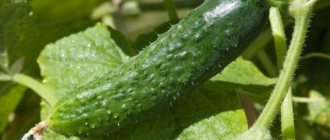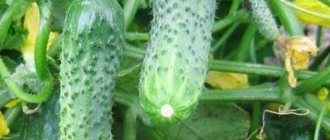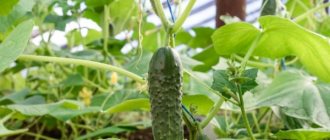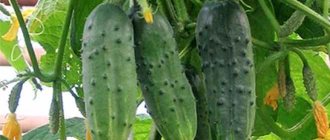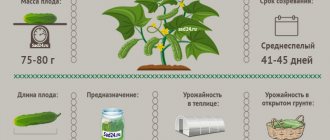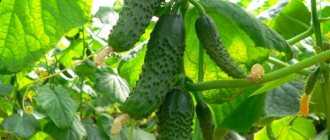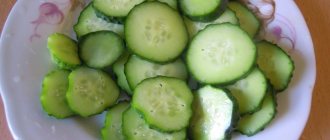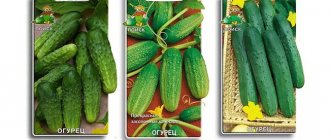- Updated: April 16, 2019
Cucumber varieties Phoenix, Phoenix 640 and Phoenix plus are the most beloved varieties of all gardeners and are therefore cultivated all over the world. They ripen very late, therefore, the first harvest can be obtained only 2 months after germination. It is advisable to grow in open ground with loose soil. Like all other varieties, they do not like drafts too much, which means that the planting site needs to be selected poorly ventilated.
Description of the Phoenix variety
There are 2 types of cucumbers under the name Phoenix. The Phoenix variety of cucumber was created in the 80s of the 20th century by a Russian breeder. Later, an earlier variety of this variety appeared. In the descriptions of the varieties presented below, you can find out what their similar and distinctive features are.
There are 2 types of cucumbers under the name Phoenix
- Phoenix or Phoenix 640, as it is sometimes called, is a sought-after cucumber variety. In 1993, it was included in the State Register of Russia. Recommended for cultivation in the Lower Volga, North Caucasus, and Central regions of Russia. The variety is late (50-62 days), needs pollination. The bush is indeterminate; without growth control it can reach 3 meters or more. The shape of the fruit is cylindrical, simple, with small tubercles and white spines. Length up to 17 cm, weight about 150 g. Purpose: salad.
- Phoenix Plus is a younger variety of the Phoenix variety. Included in the state register of Russia in 2005 and recommended for cultivation in open ground in the North Caucasus region or the Volga region. The variety is mid-season, requires pollination by bees - flowers are of the female type. The bush is indeterminate, with small light green leaves. Zelentsy are medium (50-70 g), spindle-shaped, dark green in color with thin stripes. The tubercles are small. The purpose is salad.
Important!
The Phoenix cucumber is distinguished by its medium-sized fruit and excellent taste. The skin is always without bitterness, and the pulp contains a lot of juice.
History of variety development
Phoenix cucumbers were first bred in 1980 at a breeding station in Krymsk in the Krasnodar Territory. The parent of this variety is considered to be the Soviet breeder A.V. Medvedev.
Cucumbers got their name after an epidemic of powdery mildew. The harmful fungus destroyed many seedlings and adult plants in Hungary, the German Democratic Republic, Bulgaria, and the USSR, but Phoenix turned out to be resistant to such pathogenic effects.
At that time, cucumbers did not have an official name, except for the numbers 640 to recognize the variety. Later, the official name appeared in honor of the bird that rose from the ashes - Phoenix.
Characteristics of Phoenix cucumbers
Also check out these articles
- Lightly salted cucumbers with dill
- How to feed onions?
- Tomato variety Malinovka
- Varieties of red currants
Depending on the variety, the Phoenix cucumber may have certain qualities unique to it.
| Variety of culture | Ripening period | Sustainability | Immunity | Productivity |
| Phoenix or Phoenix 640 | Late | To cold weather, unfavorable growing conditions | Downy and true powdery mildew | 4.5-6 kg/m. sq. Fruiting extended |
| Phoenix plus | Mid-season | To drought, heat | PTO, true and downy mildew | 5-6 kg/m. sq. Extended fruiting |
As you can see, the varieties described are slightly different. It should be taken into account that the features of planting and care are almost the same.
Description
“Phoenix,” like all varieties of cucumbers, is bee-pollinated , that is, it has flowers of different sexes and requires fertilization of the ovaries on female flowers with male pollen. Insects are responsible for the process of cross-pollination, so the yield largely depends on their number and activity.
Garden crops that require pollination by insects are grown mainly in open ground conditions; film shelters are used as temporary (at the initial growth stage)
In bee-pollinated varieties, the fruits tend to overgrow and turn yellow, since cucumbers ripen full-fledged seeds that can be harvested and used for planting the next season. True, with cross-pollination, varietal characteristics are “blurred” over time, especially if cucumbers of other varieties or hybrids grow nearby.
A large number of overgrown cucumbers on the vines weakens the plant, leads to drying out and shedding of the ovaries, which significantly reduces productivity.
The cucumber plant of the "Phoenix" variety is indeterminate (unlimited in growth), vigorous and branched - the lashes reach a length of up to 3 m. The type of flowering is mixed, predominantly female, that is, most of the flowers have ovaries, which are often laid in bunches at the nodes.
In the photo - greens of the "Phoenix" variety
Zelentsy are quite large (medium-fruited in accordance with GOST 1726-85), up to 16 cm long, 4-5 cm in diameter, weighing on average 150-180 g, spindle-shaped. In cross section they have a rounded triangular shape. The peel is rich green in color with long light stripes, the surface is covered with large tubercles and white pubescence. When the fruits outgrow and there is a lack of moisture in cucumbers, bitterness and hardening of the peel may appear, so you need to harvest regularly - every 1-3 days.
Cucumbers have juicy, crispy flesh with a pleasant sweetish taste and rich aroma.
Phoenix greens are declared as salad greens, that is, intended for fresh consumption, but according to numerous reviews, they are quite suitable for any type of processing - salting, pickling.
The undeniable advantages of the variety include:
- yield up to 5 kg/m2 and fruiting duration until late autumn;
- high resistance to diseases: true and downy mildew (peronospora), cucumber mosaic virus (BOM 1);
- endurance in unfavorable weather conditions of open ground: temperature changes, summer heat, insufficient soil moisture, cold snaps, etc.;
- high shelf life of fruits - the ability to be stored under normal conditions for up to 2 weeks without loss of taste and presentation.
Planting Phoenix cucumbers using the seed method
It is recommended to plant Phoenix cucumbers in permeable, aerated soil. Acidity should be between 6.3-7.2. Before planting, the soil should be fertilized with humus and mineral fertilizers. If the soil is clay, then peat and sand are also added. The site is chosen to be bright, sunny, protected from strong winds.
Interesting!
Professional gardeners recommend planting cucumbers in areas where cabbage or potatoes previously grew.
Planting Phoenix cucumbers with seeds
You can grow the Phoenix variety by seeds or seedlings. In the case of seed planting, you need to wait until the ground warms up to +15 degrees (from mid-April to early June) and only then sow cucumbers.
If the seeds are not treated with anything, before sowing they are kept for 15 minutes in a weak solution of potassium permanganate and then dried. The sowing depth of the seeds is 2-3 cm. It is easiest to sow in holes located at a distance of 30-40 cm from each other. You can put 2-3 seeds in one hole, and when they sprout, leave only one, the strongest sprout. After sowing, the seeds are covered with soil and watered. Cucumbers germinate at temperatures of +20...+30 degrees, and after 3-7 days, under favorable conditions, seedlings can be observed.
Growing cucumbers using the seedless method
Growing Phoenix cucumbers in open ground is practiced in the southern regions, where return frosts rarely occur. With this method, the seeds are planted immediately in a permanent place. Work is carried out from mid-April to early summer. First, wait until the soil warms up and a stable temperature is established. For growing cucumbers, choose illuminated areas that are protected from the wind. In the shade, plants develop slowly and bear fruit poorly.
Advice! The area for cucumbers is prepared in the fall. The soil is dug up and fertilized with manure.
The culture grows on drained humus soils with low nitrogen content. Acidic soil is limed. The bed is built 30 cm high, the optimal location is from east to west. A slight slope to the south is allowed.
Pre-planting material is kept for 10 minutes in a solution of potassium permanganate, then dried and heated. In the garden bed, make depressions of 2-3 cm, where 1 to 3 seeds are placed. They are covered with fertile soil and watered well. Leave 30-40 cm between plants. If the soil has not yet warmed up enough, you can cover the plantings with plastic wrap at night.
Planting Phoenix cucumbers with seedlings
We recommend reading our other articles
- Description and characteristics of the Kholmogory breed of geese
- How to properly prepare raspberries for winter
- Dwarf apple trees
- How to treat mastitis in cows
When growing crops using the seedling method, planting in a greenhouse is carried out in May, and in open ground in June. Seedlings begin to be harvested 25 days before planting. The substrate is prepared from 2 parts of peat, the same amount of humus and 1 part of sawdust. For nutritional value, it is recommended to add a few tablespoons of wood ash. It is best to grow seedlings in paper or peat cups.
Important!
In the shade, cucumbers develop slowly, often get sick, and the greens themselves have a less pleasant taste and may taste bitter.
Planting Phoenix cucumbers with seedlings
Seeds are planted 2-2.5 cm deep and watered. Cover the top of the container with film and keep it at a temperature of +20...+30 degrees until sprouts appear. With 12 hours of lighting, regular watering, daily ventilation (for 15-30 minutes), sprouts will appear on days 3-7.
You need to plant Phoenix cucumber seedlings in a permanent place in holes. By the time of the final transplant, the sprouts should have 3 true developed leaves. Before this, the soil is well fluffed up, watered and then planted. An average of 3-4 plants are planted per square meter. After this procedure, the ground can be mulched, but this is not necessary.
Agrotechnics of cultivation
It will take some effort to grow a decent harvest. For successful growth and high quality of cucumbers, all stages of cultivation are important. Let's take a step-by-step look at what you should pay attention to first.
Preparing the seeds
If you purchased planting material at a garden store, then there is no need to do any pre-treatment. But when the seeds are yours or donated by neighbors in the country, they must be disinfected.
- Many gardeners pre-soak the seeds in moistened gauze.
- The best way to prepare is hardening. To do this, the material is also wrapped in a damp cloth and stored in the refrigerator for several days.
- Next they are transferred to a warm place. Only after this can they be planted in open soil.
- To prevent plants from being exposed to diseases and viruses in the future, the seeds should be kept in a solution of potassium permanganate before planting.
If there is a need to pre-grow seedlings, then use ordinary soil mixed with humus.
Selecting a location and preparing the soil for planting
- Choose a spacious and well-lit place for planting fruits. Avoid dampness and areas with close groundwater flow in relation to the soil surface.
- An important condition is that the soil must be well heated. If the ground is cold, then the plant’s defenses sharply decline, the bush becomes weak, and is more often susceptible to various diseases.
- 3 seeds are planted per 1 m2 if planting is carried out in a greenhouse. In open ground you can plant 4 pieces.
- It is advisable to plant cucumbers in a place where tomatoes, onions or potatoes previously grew. The soil should be fertile, with a high content of humus.
- The permissible acidity level (PH) is 7. If the acidity is high, then in the autumn months carry out the liming procedure, you can add dolomite flour.
- Before planting, dig up the area and apply the following fertilizers: organic fertilizers, especially manure. As soon as 3 leaves appear and during the formation of the ovaries, add nitrogen-containing substances (no more than 2 g per 1 m2).
- During the entire growth period, it is necessary to feed the cucumber bush with mineral fertilizers several times. Nitrogen and potassium are used at the rate of 20 g per 1 m2.
How to properly care for cucumbers
- This heat-loving crop grows well when the air temperature is at least +20 - 22 degrees. At night the thermometer should not fall below +18.
- If it gets too cold, the growth of cucumbers stops, and in some cases the plant may die. Therefore, when the temperature fluctuates, stock up on covering material.
Watering
During the entire period of development and growth of cucumbers, you need to use 40 - 50 liters of water per 1 m2. Before the formation of ovaries, soil moisture can be maintained in a very moderate amount.
During periods of precipitation or cold weather, it is not recommended to moisten the soil. Cucumbers do not like this very much, so the plants should be watered exclusively with warm water.
Recommendations
- You cannot plant cucumbers in one place for several years in a row. Productivity falls, and plants often get sick.
- Do not rush to plant; if the soil is not warmed up, the seeds may simply not sprout.
- Be sure to fertilize the soil before planting. This will help the cucumbers develop and grow more actively.
- Leave a gap of at least 20 cm between planting holes so that the plant has enough room to grow.
- It is important to water the cucumbers regularly, and also not to forget about loosening. This way the bushes will receive the required amount of oxygen.
- Fertilizing should be done after watering.
- Collect small fruits, as overripe cucumbers greatly inhibit the development of other ovaries.
- It is advisable to cut ripe fruits rather than pick them. This way you will not damage the tissue of the stems or the root part.
- After 5 - 6 adult developed leaves appear, you need to pinch the top of the stem so that barren flowers do not form.
- When the second ovary is formed, remove the side shoots at a distance of 30 cm.
Caring for cucumber plantings
With proper care, the Phoenix cucumber can please you with a very large, high-quality harvest.
- It is recommended to grow Phoenix cucumbers on a trellis because they can grow very tall, especially in a greenhouse. They begin to be tied after the appearance of 4 leaves.
It is recommended to grow Phoenix cucumbers on a trellis
- Watering is done exclusively with warm, settled water after sunset. You can water the bushes at the root or by sprinkling. Before flowering begins, water is added once a week, after the buds appear - once every 3 days.
- After watering, it is necessary to loosen the soil so that it does not become too compacted. Good aeration is the key to healthy, strong bushes.
- Since the bushes can grow very tall, it is necessary to remove all previous stepsons after the appearance of 3 leaves. Thus, a powerful root system will be formed, and the cucumbers will produce more yield. The same procedure is done after the appearance of the 8th leaf.
- To stimulate the growth of new roots, you can hill up the bushes 1-2 times per season.
- Fertilizers are applied once every 2 weeks from the beginning of flowering. Before the ovaries appear, you can use dung or mullein (a weak solution), and when young cucumbers appear, it is better to use superphosphate in a concentration of 35 g/10 l of water.
Features of planting and care
There are no special differences in cultivation and care for Phoenix compared to other varieties. It is planted according to the scheme and grown on trellises. They can be made from slats. But many gardeners actively use twine, stretching it between posts driven into the edges of the beds. Phoenix grows well outdoors and in greenhouses.
Phoenix is convenient to grow on trellises
Try long-fruited cucumber varieties from a trusted supplier:


